views
The concept of 3D printing is often considered to be one of the biggest revolutions across the globe. 3D printing is an additive manufacturing technology that prints an object layer by layer using digital files as a template. Various industry stakeholders and academicians have undertaken initiatives to further develop / improve this technology for a variety of applications. For instance, it can be used to print living cells and develop highly complex tissues that mimic the structure and performance abilities of desired organs within the human body. Advancing the same, significant strides have been made to further enhance the 3D bioprinting technology to include one dimension; this is referred to as 4D bioprinting technology. Smart materials enable this advancement as they have the ability to adapt to spatiotemporal framework in the presence of different physical and chemical stimuli.
It is worth mentioning that 4D bioprinting was first introduced by Massachusetts Institute of Technology’s (MIT) Self-Assembly Lab, in collaboration with Stratasys (3D printer manufacturer) and Autodesk (3D Software company). The extra dimension involved in 4D bioprinting aids the 3D printed objects to change their shapes using external stimuli (such as chemical, thermal, light and magnetism) or internal stimuli (referring to the inner force triggered shape deformations). Even though this is a novel technology, it can assist in mitigating several real-time problems of the manufacturing industry.
There are three basic steps involved in bioprinting, these are pre-bioprinting, bioprinting and post-bioprinting.
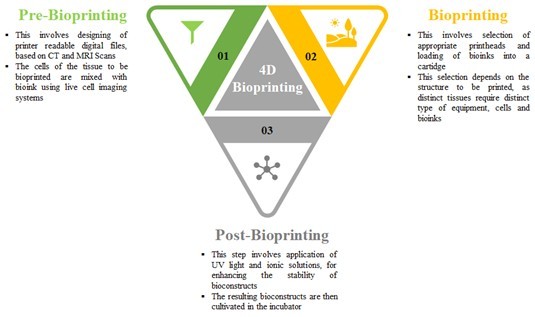
Working Principle of 4D Bioprinting
According to a research article published in 2020, Farhang Momeni and Jun Ni had put together three laws that provide a better understanding of the shape changing behaviour of 4D printed structures.
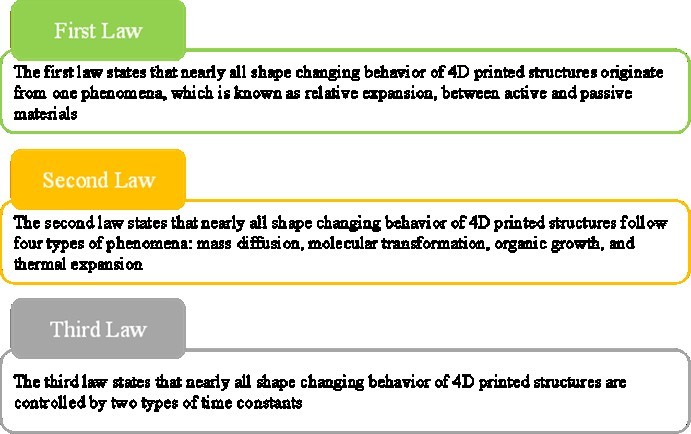
Stimuli Responsive Materials in 4D Bioprinting
The equipment used in 4D bioprinting are identical to that used in 3D printing, however the materials used are different (in terms of their response to external stimuli). The process is typically initiated by an external stimulus, including physical and chemical factors, which allow more specific control.
Factors Affecting 4D Bioprinting
Following are the physical factors affecting 4D bioprinting:
§ Humidity: It is the one of the most used physical stimuli for 4D bioprinting. Water sensitive materials swell, twist and fold to absorb and release moisture.
§ Temperature: It is one of the most frequently used physical stimuli. Materials that respond to temperature are known as thermo-responsive materials. These materials are capable of returning to their original shape easily, post deformation, and thus, have good shape memory.
§ Electric field: Electric field responsive materials are known as polyelectrolytes. Electric field can induce deformations, such as swelling, shrinking and bending.
§ Magnetic field: This involves the use of paramagnetic or ferromagnetic nanoparticles. A bio-fabrication method for producing innervated secretory epithelial organoids has been proposed using magnetic 3D bioprinting technology, which regulates the assembly and orientation of anisotropic micro-biomaterials, as building blocks during the printing process.
§ Light: Photo-responsive materials are widely used in biomedical applications. These materials can be activated by providing exposure to light, with varying wavelengths, including the near-infrared (NIR), infrared (IR) and ultraviolet (UV) areas. The most common mechanism of action of these materials are photodegradation and photoisomerization of polymer chains.
§ Acoustic: Acoustic force patterning is a promising method for the construction of contactless, quick and precise location-controlled cell platforms.
The chemical factors affecting 4D bioprinting are mentioned below:
§ pH value: Materials that respond to pH can either accept or contribute protons, affecting the pH, and can bring structural changes in polymer chain by swelling, bending or shrinking. The polymer chain can also undergo structural changes, from globule to coil.
§ Ion concentration: Numerous recent studies have shown methods for creating scaffolds with enough strength to support cell-filled therapeutic constructions. In order to create scaffolds with adequate strength and controllable mechanical qualities for bioprinting, crosslinking with multivalent ions, such as Ca2+ and Zn2+, have been used.
Technologies Used in 4D Bioprinting
There are six key technologies used of 4D bioprinting. The principles of these technologies have been discussed below.
§ Stereolithography (SLA): The SLA machine begins the 3D printing process by drawing the layers of the support structures, followed by the part itself, with an ultraviolet laser focused onto the surface of a liquid thermoset resin. After a layer is imprinted on the resin surface, the build platform lowers and recoating bar shifts over the platform to apply the next layer of resin. The method is continued layer by layer until the construction is finished. Newly built parts are removed from the machine and brought to a lab where solvents are used to remove any remaining resins. The support structures are manually removed once the parts have been thoroughly cleaned. After that, the parts go through a UV-curing cycle to thoroughly firm the outside surface. The application of any custom or customer-specified finishing is the final stage in the SLA process.
§ Selective Laser Sintering (SLS): SLS process begins with the build chamber, that is first heated to a temperature just below the melting point of the powdered material, which is most commonly Nylon PA12. When the temperature reaches the predetermined level, a leveler brings the initial layer of material and spreads it in the build chamber. This brings the CO2 laser into action, as it melts and fuses the particles together. Thus, this process is also known as Powder Bed Fusion / Sintering. This process is repeated to trace the next layer over the previous one in the same chamber. This time, in addition to the current and prior layer fusing together to produce two entirely joined layers, the nearby particles are also fused. This procedure is repeated until the entire object is printed. Before the part is removed, the build chamber is given time to cool, which takes a while to complete. After being removed, the component is cleaned by being blasted with compressed air, which may be followed by tumbling, stove enameling, bead blasting and many more, depending on the requirement.
§ Fused Deposition Modeling (FDM): FDM printing begins with raw material being extruded as a thin filament through the heated nozzle. This thin filament deposits down on the printer platform’s bottom and solidifies. This process continues with the layers being fused over one another. It is worth noting that the most FDM printers print the layer's outer edges first, followed by the inner borders and, lastly, the final layer is inside, which is typically printed as either a solid layer or a fill-in matrix.
§ Jet 3D Printing (3DP): Jet 3D Printing begins with heating the liquid resin to 30oC to 60oC, to acquire the ideal viscosity for printing. This is followed by hundreds of tiny droplets of photopolymer being deposited / jetted to the required areas as the printhead passes over the build platform. The deposited material is cured by a UV light source that is connected to the printer, hardening it and forming the first layer of the part. The build platform descends one step (equivalent to height of a layer) after the layer is finished, and the procedure is repeated until the entire portion is finished.
§ Selective Laser Melting (SLM): In contrast to the powder bed fusion processes, such as SLS, SLM completely melts the metal. SLM printing is done by a powerful laser which selectively melts layer-by-layer into a component. The roller / re-coater applies a small layer of powder from the power stock onto the build platform to signal the start of the printing process. A controlled scanning mirror then focuses and directs the laser to selectively melt the powder into the shape of the first layer. When this layer has cooled to the proper degree, the build platform moves in the downward Z direction while the powder stock moves in the upwards Z direction. The printing procedure is repeated for each subsequent layer, up until the last item is enclosed in unused powder on the build platform.
Applications of 4D Bioprinting
Even though 4D printing technology is still in its early phases of development, it has already attracted a lot of attention from numerous research and technological domains. Some of its applications have been highlighted in the following figure.
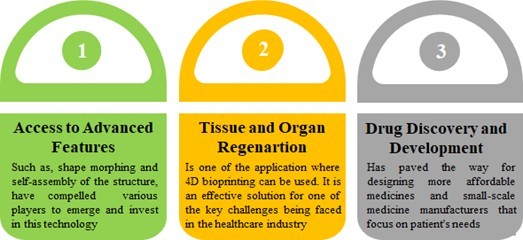
Challenges Associated with 4D Bioprinting
Although significant efforts are being made in this domain, which have shown encouraging advancements as well, there are several challenges that still need to be addressed in this domain.
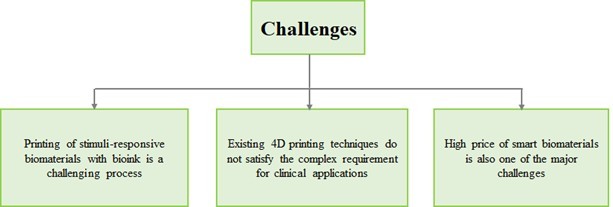
Future Perspectives
Four-dimensional bioprinting uses cells and / or stimuli-responsive biomaterials to impart the ability for structural changes in printed structures, in a controlled manner. Depending on the stimuli, such as heat, water, light, electricity, magnetic energy, stress, strain and pressure, 4D structures can morph over time. Further, with the aid of 4D bioprinting, the printed structures have the ability to physically mimic the development path of biology and advance the idea of printing organs. In addition, these structures can put themselves together, repair themselves and adapt to changes on their own. It is important to highlight that the research and development of 4D printing technologies is still in its early phases. However, given the promising applications of this technology in the healthcare sector (such as tissue engineering and chemotherapy), increasing research activities have been reported in the market, which is likely to drive noteworthy growth for the 4D bioprinters market.
Roots Analysis
Roots Analysis is a global leader in the pharma / biotech market research. Having worked with over 750 clients worldwide, including Fortune 500 companies, start-ups, academia, venture capitalists and strategic investors for more than a decade, we offer a highly analytical / data-driven perspective to a network of over 450,000 senior industry stakeholders looking for credible market insights. All reports provided by us are structured in a way that enables the reader to develop a thorough perspective on the given subject. Apart from writing reports on identified areas, we provide bespoke research / consulting services dedicated to serve our clients in the best possible way.











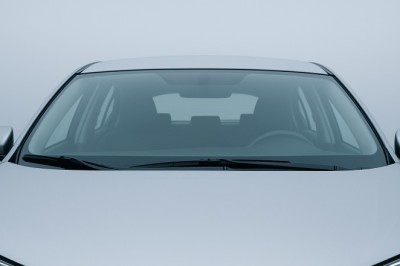
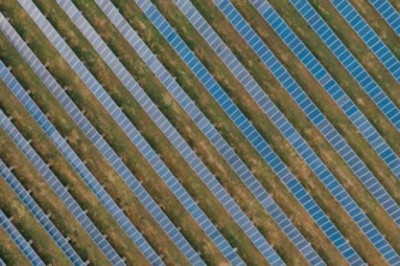

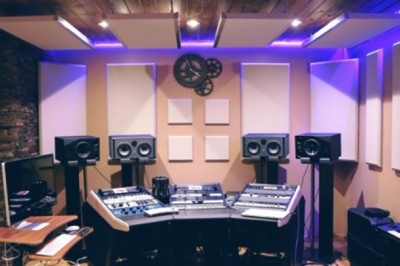





Comments
0 comment